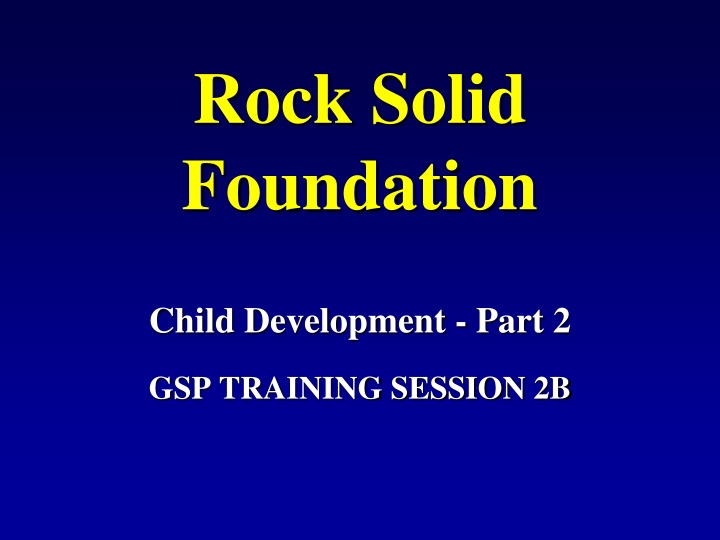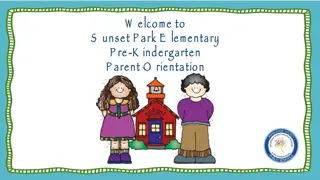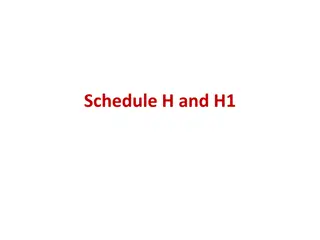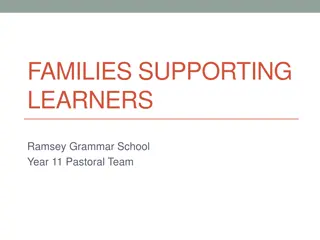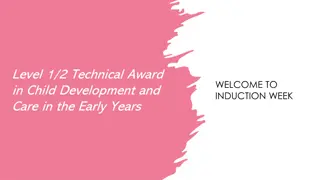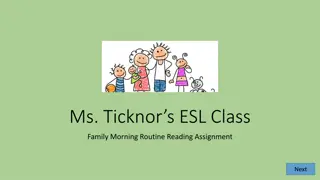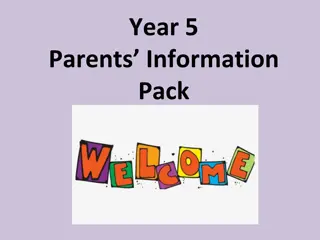Child Development: Daily Routine and Schedule
In Part 2 of Child Development, explore the importance of developing a daily routine and schedule for children of different styles, such as inward, outward, and closed. Learn how setting rules, rewards, consequences, and a structured daily schedule can positively impact behavior management and security. Discover the significance of behavior contracting and establishing clear rules.
Download Presentation

Please find below an Image/Link to download the presentation.
The content on the website is provided AS IS for your information and personal use only. It may not be sold, licensed, or shared on other websites without obtaining consent from the author.If you encounter any issues during the download, it is possible that the publisher has removed the file from their server.
You are allowed to download the files provided on this website for personal or commercial use, subject to the condition that they are used lawfully. All files are the property of their respective owners.
The content on the website is provided AS IS for your information and personal use only. It may not be sold, licensed, or shared on other websites without obtaining consent from the author.
E N D
Presentation Transcript
Rock Solid Foundation Child Development - Part 2 GSP TRAINING SESSION 2B
Child Development - Part 2 In Part 1 of Child Development, we discussed a summary of the child development process and etiology of developmental delays In Part 2 we will discuss the implications for treatment Beginning with the Daily Routine and Schedule ..
Developing a Daily Routine and Schedule Each of the following categories of children need much the same thing, albeit for different reasons Inward style children need structure (rules, rewards, consequences, consistency) in order for them to make the link between cause and effect and experience the reinforcement necessary to manage behavior
Developing a Daily Routine and Schedule Outward style children need structure so that they may begin to be able to evaluate themselves against an objective standard Closed style children need a structure in order to know what to expect and feel secure
Developing a Daily Routine and Schedule Therefore, each foster home will need to determine beforehand what the rules, rewards, consequences and daily schedule will be These policies will need to be written and made to be a part of the daily program of the facility
Developing a Daily Routine and Schedule Daily Routine and Leisure Time Activities
Behavior Contracting Reason and Rules In giving children reasons, the child is able to reason out consequences and gives him a principle to follow
Behavior Contracting Rules About Rules Remember, rules are really for the adults Short Positive Easy to remember Specified behavior and consequences Easily enforceable Teachable
RULES, PAYMENTS, CONSEQUENCES Rules Payment Privileges Withdraw Privileges Consequences Keep daily Schedule (Whereabouts at all times) Keep hands/feet to self (Health and Safety) Knock/gain permission (Privacy) Ask/gain permission (Property) Obey FPS first time (Supervision/Authority) If don t know Ask (Cover all Bases) Special Contract Special Contract Special Contract Redirection - Restriction Redirection Withdraw privileges Restitution - Fine Withdraw privileges or other Withdraw privileges or other
Behavior Contracting Trouble shooting the Behavior Contract The Contract Was the target behavior clearly specified? Did the contract provide for immediate reinforcement? Did it ask for small approximations to the desired behavior? Was reinforcement frequent and in small amounts?
Behavior Contracting The Contract Did the contract call for and reward accomplishment rather than obedience? Was the performance rewarded after its occurrence? Was the contract fair? Were the terms of the contract clear? Was the contract honest?
Behavior Contracting The Contract Was the contract positive? Was contracting as a method being used systematically? Was the contract mutually negotiated? Was the penalty clause too punitive?
Behavior Contracting The Client Did he understand the contract? Is he getting the reinforcer from some other source? Do the reinforcers have to be reevaluated? Has a new problem behavior developed that is drawing the mediator's attention away from the target behavior?
Behavior Contracting The Mediator Did the mediator understand the contract? Did he dispense the kind and amount of reinforcement specified in the contract? Did he dispense it according to instructions, at the rate specified, and with consistency? Did punishment accidentally accompany the performance being reinforced? Did he stop mediating? Do you need a new mediator?
Behavior Contracting The Measurement Has the data been verified as accurate? Did your data collector understand what he was supposed to count? Did you rehearse the counting task with him? Did you reinforce him for his behavior? Is the data collection task too complex or too difficult? Should you try to get another data collector?
Behavior Contracting Contract Effective Dates: From We, the undersigned parties, agree to perform the following behaviors: If _________________________ ________________________ _________________________ If _________________________ ________________________ _________________________ Bonus _____________________________________________________ _____________________________________________________ Penalty _____________________________________________________ _____________________________________________________ to Then ________________________ Then ________________________ _________________ Client _________________ Mediator
A.I.M. ASSESSMENT OF INHERENT MOTIVATION Chester J. Singer, Ph.D. (1988)
A.I.M. 40 Questions Each for Examiner and Client Read each statement carefully and darken the circle under YES if it "generally" describes the client (if client questionnaire YOU) NO if it does not describe the client (if client questionnaire YOU) Use the accompanying answer sheet to record your responses
A.I.M. Record the number of Yes answers in each of the four columns Closed Inward Outward Open 25 . 18 25 18 17 . 2 1 2 1
A.I.M. If the yes answers to the questions were as follows for the examiner: Closed 12, Inward 21, Outward 9, Open - 8 And the yes answers to the questions were as follows for the client: Closed 7, Inward 3, Outward 16, Open - 14 The resulting A.I.M. chart would be as follows:
A.I.M. Chart Example 25 25 21 20 20 16 Examiner 15 15 14 12 Client 10 10 9 8 7 5 5 3 0 0 Closed Inward Outward Open
A.I.M. Handouts for A.I.M. Activity Examiner Assessment Client Self Report Score Sheets Graph material
Child Development Feedback 1. What is the most important gift that a foster parent can give to a child in therapeutic foster care? A. Love and affection B. Consistent rules and consequences C. Communication D. Restrictions for rule violations E. Rewards for positive behavior B. Consistent rules
Child Development Feedback 2. In the behavioral contract, what is the best evidence that a target behavior is clearly specified? A. The child understands it B. It can be observed and counted C. The child accomplishes it D. The child agrees with it B. Observed and counted
Child Development Feedback 3. The most effective house rules are those which: A. Tell the child what is prohibited B. The child agrees with C. Tell the child what (s)he should do D. Are gratifying to the foster parent C. Tell child what (s)he should do
Child Development Feedback 4. The most important reason behavioral reinforcement should be immediate is because: A. Otherwise the foster parent may forget B. Children are more likely to repeat a behavior that is positively reinforced immediately C. That's what children want D. Children will link their actions to the consequences and learn "cause and effect" more readily when reinforced immediately D. Children will link
Child Development Feedback 5. Threatening a child with removal from the foster home is not a good discipline tool because: A. Children should never be denied basic human needs as punishment B. Foster parents may not really mean what they say in the heat of emotion C. Children are likely to test the threat D. Regulations prohibit it E. All of the above E. All of the Above
Child Development Feedback 6. The most basic of human needs is: A. Love and Affection B. Approval C. Self-esteem D. Health and Safety D. Health and Safety
Child Development Feedback 7. Children whose primary need is approval need foster parents who: A. Praise them for good behavior B. Disapprove of them for bad behavior C. Seek their opinion on matters D. Provide them opportunities for self- evaluation E. A and C F. C and D F. C and D
Child Development Feedback 8. A child should be punished every time he or she does something wrong. A. True B. False B. False
Child Development Feedback 9. Explain your answer to number 8:
Child Development Feedback 10. Define Locus of Information The relative emphasis a person places on gaining information to make behavioral decisions from within her/himself
Child Development Feedback 11. State the Basic need for each of the following loci of information: Closed/immature Security, predictability, script Inward/internal Immediate self-gratification, behavior contract
Child Development Feedback Outward/External Acceptance, approval, self- monitoring program Open Self-Actualization; opportunity
